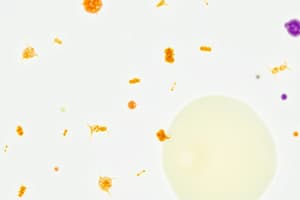Podcast
Questions and Answers
Strep and Staph are both what?
Strep and Staph are both what?
- Gram variable
- Gram positive (correct)
- Gram negative
- Atypical
How can you tell the difference between strep and staph on gram stain?
How can you tell the difference between strep and staph on gram stain?
Streptococci line up one after the other like a strip of button candy, while staphylococci appear as clusters.
Does streptococci possess catalase?
Does streptococci possess catalase?
False (B)
What are the three groups of strep based on their hemolytic ability?
What are the three groups of strep based on their hemolytic ability?
Which strep group is classified as beta-hemolytic?
Which strep group is classified as beta-hemolytic?
What are Lancefield antigens?
What are Lancefield antigens?
What is Group A lancefield strep?
What is Group A lancefield strep?
What is Group B lancefield strep?
What is Group B lancefield strep?
Group D lancefield strep includes which two types?
Group D lancefield strep includes which two types?
What is the main disease caused by Streptococcus pneumoniae?
What is the main disease caused by Streptococcus pneumoniae?
What components of Strep pyogenes cell wall are antigenic?
What components of Strep pyogenes cell wall are antigenic?
What enzyme is crucial for Group A beta-hemolytic strep pathogenicity?
What enzyme is crucial for Group A beta-hemolytic strep pathogenicity?
Flashcards are hidden until you start studying
Study Notes
General Characteristics of Strep and Staph
- Both Strep (Streptococcus) and Staph (Staphylococcus) are classified as gram positive bacteria.
Distinguishing Strep from Staph
- On gram stain, Streptococci align in chains or pairs resembling a strip of candy, while Staphylococci form clusters, akin to a group photo of hospital staff.
- Streptococci divide in one plane, leading to their characteristic chain formation.
Catalase Production
- Streptococci do not produce catalase, contrasting with Staphylococci which do.
- Catalase converts hydrogen peroxide into water and oxygen, helping protect Staphylococci from oxidative damage.
Hemolytic Properties of Streptococci
- Streptococci can be categorized based on hemolytic ability:
- Beta-hemolytic: Completely lyses red blood cells, creating a clear halo (e.g., S. pyogenes).
- Alpha-hemolytic: Partially lyses red blood cells, resulting in a greenish hue (e.g., S. pneumoniae).
- Gamma-hemolytic: No lysis of red blood cells; not typically referred to as hemolytic (e.g., E. faecalis).
Lancefield Antigens
- Classification of Streptococci includes Lancefield antigens, which are identifiable C carbohydrates on cell walls, labeled A-S.
- Primarily used for beta-hemolytic strains; however, reliance on this system has decreased due to the diversity of Streptococcus species.
- Notable human pathogenic groups include:
- Group A, B, and D (have Lancefield antigens)
- Streptococcus pneumoniae and Viridans group Strep (lack Lancefield antigens).
Group Identifications
- Group A Lancefield Strep: Streptococcus pyogenes
- Group B Lancefield Strep: Streptococcus agalactiae
- Group C/G Lancefield Strep: S. milleri and S. dysgalactiae; associated with strep throat.
- Group D Lancefield Strep: Includes Enterococci like E. faecalis and E. faecium, as well as Non-enterococci like S. bovis, which can cause endocarditis linked to gastrointestinal issues.
- Viridans Group Strep: Comprises various species like S. salivarius, S. mitis, S. sanguis, and S. mutans, known for potential alpha hemolytic or non-hemolytic properties and associations with endocarditis.
Disease Associations
- Streptococcus pneumoniae: Recognized cause of bacterial pneumonia.
- Group A Beta-hemolytic Strep: Also known as Strep Pyogenes, known to cause:
- Strep throat
- Scarlet fever
- Rheumatic fever
- Post-streptococcal glomerulonephritis.
Antigenic Components of Group A Strep
- C-Carbohydrate: Specific to S. pyogenes, used in Lancefield classification.
- M Protein: Major virulence factor inhibiting complement activation and phagocytosis. However, serves as a target for antibodies aiding in bacterial clearance.
Enzymatic Contributions to Pathogenicity
- Streptolysin O: Oxygen-labile enzyme causing destruction of red and white blood cells, contributing to beta-hemolytic activity.
- Following an infection, the body produces anti-streptolysin O (ASO) antibodies, which can be detected in ASO titer blood tests.
Studying That Suits You
Use AI to generate personalized quizzes and flashcards to suit your learning preferences.




